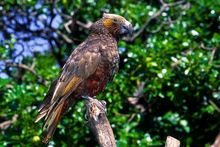 Since six kaka were reintroduced to Zealandia in central Wellington in 2002, their numbers – boosted by some more reintroductions – have climbed to around 200, although they’re hard to count as they fly freely in and out of the fenced sanctuary. These large native forest parrots have become a common sight around the central city, frequenting parks, the botanic gardens, the town belt and suburban gardens. The bird pictured at left is an adult male North Island kaka (image © Albert Aanensen from NZ Birds Online)
Since six kaka were reintroduced to Zealandia in central Wellington in 2002, their numbers – boosted by some more reintroductions – have climbed to around 200, although they’re hard to count as they fly freely in and out of the fenced sanctuary. These large native forest parrots have become a common sight around the central city, frequenting parks, the botanic gardens, the town belt and suburban gardens. The bird pictured at left is an adult male North Island kaka (image © Albert Aanensen from NZ Birds Online)
Their habit of stripping bark to get at sap has been causing damage to some large trees such as eucalypts and macrocarpas, and Wellington Botanic Gardens staff have had to remove some dying branches to prevent them falling. The kaka also feed on seeds and cones on old pine trees.
Victoria University of Wellington master’s student Kerry Charles looked at the impact of these urban kaka on city trees, documenting damage, observing kaka feeding and trying to work out which birds were doing the sap feeding and what kind of trees they favoured. She tells Alison Ballance that she made 40 observations of birds sap feeding, and found that birds of both sexes and all ages were involved, including birds that were also regularly easting supplementary food at Zealandia. They favoured exotic trees in prominent positions on ridge tops. Kerry’s advice to Wellington City Council has been to consider a phased-in replacement of exotic trees with natives.

